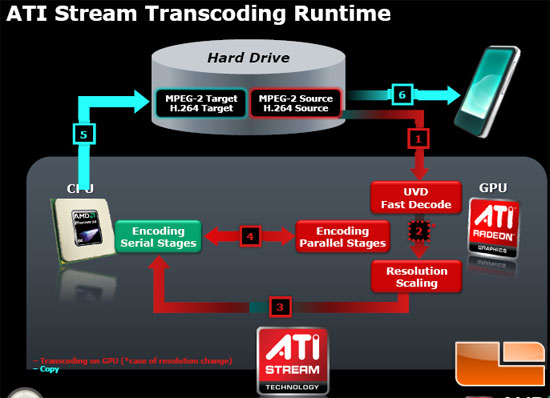Cyberlink MediaShow Espresso GPGPU Performance
GPU Compute: AMD Versus NVIDIA on Espresso
AMD announced this morning that users of its computing platforms can accelerate new video editing and processing software from a range of developers. By running applications on the GPU rather than entirely on the CPU, it has been found to reduce the time required to perform intensive tasks like converting a large, high-definition file into something suitable for viewing on a portable media player. An example of software that can take advantage of the power of a graphics card is CyberLinks MediaShow Espresso video converter application.

CyberLink MediaShow Espresso software has been designed to work with both AMDs Unified Video Decoder (UVD) through its ATI Stream technology and NVIDIA’s general purpose parallel computing architecture known as CUDA. By using AMD Stream and NVIDIA CUDA technology consumers can quickly convert digital video files for use on portable devices like the Apple iPhone, Sony PS3, and YouTube. Since CyberLink MediaShow Espresso works on both NVIDIA and AMD graphics cards it gives us a rare chance to benchmark both technologies to see which is better. AMD announced a Catalyst 9.5 hotfix driver for ATI graphics cards this morning as well that improves compatibility with the latest version of espresso and resolves some quality issues found in using Catalyst 9.5. Basically, the ATI Stream Transcoding in CATALYST 9.5 hotfix has been tweaked for even better performance with MPEG-2 and H.264 video files.

But Wait. There’s More! If that doesn’t do it for you then you’ll jump for joy when you hear that MediaShow Espresso has also been optimized for Intel Core i7 processors! This means that MediaShow Espresso takes advantage of Intel’s Hyper-Threading technology in Core i7 processors to enhance CPU performance and efficiency. The Intel Core i7 series of processors can process 8 threads at one time leveraging each core’s ability to execute operations from 2 software threads simultaneously. Allowing the CPU to execute multiple software threads at the same time results in an overall boost in performance for MediaShow Espresso users when transcoding videos. Cyberlink says that the optimizations for Intel Core i7 help so much that they boost performance for HD video conversion by 142% when compared to an Intel Core 2 Quad processor.

Today, we’ll be comparing the GPU compute power of two $99 graphics cards using MediaShow Espresso as the benchmark. AMD will be represented by the ATI Radeon HD 4770 512MB graphics card and NVIDIA will be sporting the GeForce 9800 GTX+. At $99 after rebate, both of these cards feature the same price points and are direct competitors in the retail channel. When it comes to processors we couldn’t settle on one, so we went with the Intel Core i7 965 processor for our enthusiast system and then the AMD Athlon X2 4850e for our entry level system. By doing this we will see how big of a difference a CPU plays on GPU compute power. Even though both AMD Stream and NVIDIA CUDA can be used, not all the conversion of digital video takes place on the GPU. AMD even clearly states that ATI Stream is a set of advanced hardware and software technologies that enable AMD graphics processors (GPU) to work in concert with the systems central processor (CPU) in order to accelerate applications beyond just graphics. Obviously, a mixture of the CPU and GPU will be needed to lead the benchmarks. The question is which, if any, company has the right combination of hardware and software power to finish the benchmarks first.

Comments are closed.